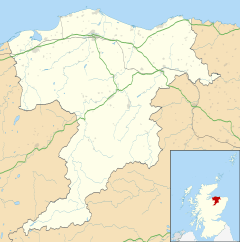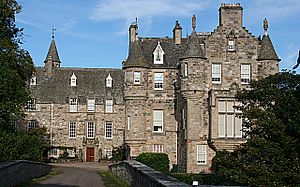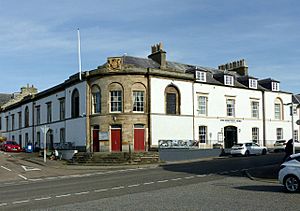Cullen, Moray facts for kids
Quick facts for kids Cullen
|
|
|---|---|
 Looking west over Cullen, with Cullen Viaduct on the left |
|
| Population | 1,390 (2020) |
| OS grid reference | NJ512672 |
| Council area | |
| Lieutenancy area | |
| Country | Scotland |
| Sovereign state | United Kingdom |
| Post town | BUCKIE |
| Postcode district | AB56 |
| Dialling code | 01542 |
| Police | Grampian |
| Fire | Grampian |
| Ambulance | Scottish |
| EU Parliament | Scotland |
| UK Parliament |
|
| Scottish Parliament |
|
Cullen (Scottish Gaelic: Inbhir Cuilinn) is a lovely village on the North Sea coast of Scotland. It's in an area called Moray, but it used to be part of Banffshire. Cullen is about 20 miles (32 km) east of Elgin. In 2001, about 1,327 people lived here.
Cullen has a special connection to Robert the Bruce, a famous Scottish king. It's believed that parts of his wife's body were buried in Cullen's old church after she died at Cullen Castle. King Robert was so grateful for the care given to his wife that he promised the village a yearly payment. This payment was stopped for a while, but in 2000, the village successfully fought to get it back.
Contents
Cullen's Long History
Cullen has a very long and interesting past. It became a "royal burgh" sometime between 1153 and 1214 AD. A royal burgh was a special town that had rights given directly by the King or Queen. This meant the town had more freedom to govern itself and trade. King James II also gave Cullen a special charter in 1455 AD. The royal burgh system ended in 1975.
Ancient Mentions of Cullen
The area around Cullen was mentioned a long time ago. A geographer named Ptolemy wrote about a river called Celnius between 139 and 161 AD. Experts believe this was the Cullen Burn. The first time Cullen was mentioned in Scottish history was in 962 AD. This was when King Indulf was killed by Vikings (Norwegians or Danes) near the mouth of the Cullen River. This event is known as the Battle of the Bauds.
The Legend of the Three Kings
There's a local legend about three kings being buried near Cullen. It says that a Scottish, a Danish, and a Norwegian king are buried close by. Three isolated rocks in Cullen Bay are called the "Three Kings" and are said to mark their graves. However, some people think the rocks got their name because Cullen sounds like "Culane" (Cologne). "The Three Kings of Culane" was a medieval play.
Robert the Bruce's Connection
The church in Cullen was first built as a chapel by King Robert the Bruce. As mentioned, parts of his wife's body were buried in its old church after she died at Cullen Castle. King Robert then made a yearly payment to the village to thank them for looking after his wife's body before it was taken south for burial. This payment stopped after a change in local government in 1975. But in 2000, the village successfully argued to get this payment restarted.
Robert Burns Visits Cullen
The famous Scottish poet Robert Burns stayed overnight in the old town of Cullen in 1787. He was on a tour of the Highlands. He wrote that the country up to Cullen was "sadly poor and unimproved."
Moving the Town
The original town of Cullen was knocked down in 1822. Its remains are now next to Cullen House. The idea to move the town started with James Ogilvy, 7th Earl of Findlater. But it was his successor, Ludovick Ogilvy-Grant, 5th Earl of Seafield, who actually made it happen. The town was moved about 0.5 miles (800 m) away. This was done to make the town more modern, as the old houses often flooded. It also gave the Earl more privacy. The new town was designed by George MacWilliam and built between 1820 and 1822.
The central market cross in the town square used to be in the old town. When the new town was being built, it was placed temporarily on Castle Hill. This is an ancient fort that guards the entrance to the Cullen Burn. This is why the village looks the way it does today. It has a cross shape with two main streets, Seafield Street and Grant Street. There's also a central town square and "the Seatown" area. The Seatown is right by the beach, between the burn (a small river) and the harbour. The most important building in the new town is Cullen Town Hall, finished in 1823.
Fishing Industry and Cullen House
The fishing industry grew quickly in the 1880s. The harbour was very busy with large fishing boats. Later, steam-powered boats became popular. Over time, the fishing industry moved to bigger harbours. This was because boats became larger and needed deeper water. The site of Cullen railway station was redeveloped after the station closed in 1968.
The main part of Cullen House was built in 1543. An east wing was added in 1711, and more changes were made in 1858. In 1983, the House and its estate buildings were turned into fourteen homes. Before Cullen House, the Earls of Seafield lived at Findlater Castle. This castle is now a ruin on a rocky part of the coast, about 2 miles (3 km) to the east.
What to See in Cullen Today
Today, Cullen has a population of about 1,327 people. It gets much busier in summer than in winter. This is because many people own holiday homes there. The village has a lovely beach and a golf course. The Bin Hill (or Bin of Cullen) is a nearby hill that is 1,086 feet (331 m) tall. There's a footpath to the top if you like hiking.
Cullen in Books and Radio
Cullen has been the setting for some stories. Doris Davidson's romantic novel The Three Kings is named after the three rocks on Cullen beach. A local writer named Simon Farquhar set his first two plays in the village. These plays, Candy Floss Kisses and Elevenses with Twiggy, were broadcast on BBC Radio 4.
Not everyone loved Cullen, though! Samuel Johnson, a famous writer, visited Cullen with his friend James Boswell. Boswell wrote that they thought Cullen had "a comfortable appearance, though but a very small town, and the houses mostly poor buildings." Dr Johnson was also "disgusted by the sight of" the "dried haddocks broiled" that they were served for breakfast and refused to eat them!




